What Brown Saw and You Can Too
II. History
This section describes how the plant Clarkia pulchella of the American Northwest came to be grown in England.
A. Lewis
In 1778, 1785 and again in 1792, the American botanist Humphrey Marshall (1722-1801) proposed to the American Philosophical Society of Philadelphia that they support a botanical expedition westward to the Pacific ocean.(1) Thomas Jefferson (1743-1826) joined the Society in 1790. He heard the last proposal and tried to advance it in 1793, but the project foundered.
On June 20, 1803, first term President Thomas Jefferson sent a formal letter to his private secretary and aide Meriwether Lewis (1774-1809), a captain in the 1st U. S. Infantry. It requested that he head an expedition up the Missouri River to find a navigable route to the Pacific Ocean. No mention in this letter was made of botany, but Jefferson had it in mind. Following Jefferson's recommendation, as part of his preparation, in Philadelphia, in May and June of 1803, Lewis took a crash course in botany from Benjamin Smith Barton (1766-1815), who had written the first American textbook on the subject.
 |
| Meriwether Lewis |
Lewis was authorized to choose a co-commander, and he chose William Clark (1770-1838), who had earlier been Lewis's commanding officer. On May 14, 1804, the Lewis and Clark expedition set out from St. Louis.(2) They reached the Pacific at the mouth of the Columbia River on Nov. 7, 1805:
OCEAN in view! Oh! The joy!
wrote Clark in his journal.(3) They returned on September 23, 1806, having accomplished all that was asked of them and more.
On the return journey, while waiting for a month in the Kamiah Valley of Idaho for the snow to melt in the mountains, Lewis wrote on June 1, 1806:
I met with a singular plant today in blume, of which I preserved a specemine. It grows on the steep sides of the fertile hills near this place.
and he gave a detailed botanical description of the flower, concluding with:
I regret very much that the seed of this plant are not yet ripe and it is probable will not be so during my residence in this neighborhood.
B. Pursh
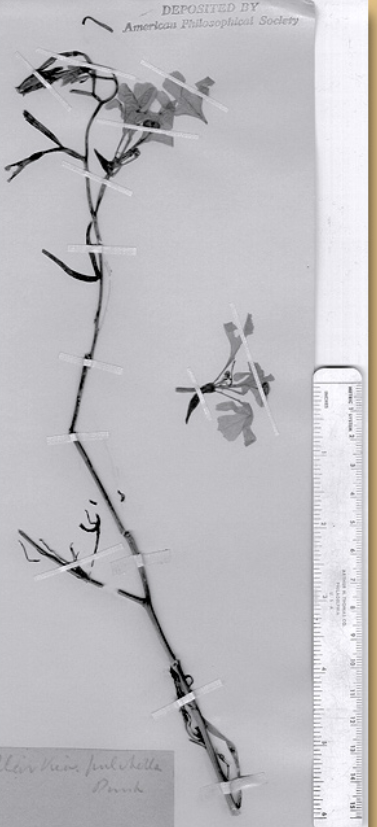 |
| Lewis's specimen of Clarkia pulchella (Academy of Natural Sciences, Philadelphia) |
Upon his return, in April 1807, since Barton had failed to do anything with specimens sent on earlier, Lewis sought the advice of Bernard McMahon (1775-1816). He was a Philadelphia seedsman esteemed by Jefferson and entrusted to grow the seeds brought back by Lewis. McMahon suggested employing Frederick Traugott Pursh (1774-1820), the curator (and often collector) of Barton's collection. Lewis hired Pursh to prepare a catalog of the plants he had collected.
Unhappy working for Barton, Pursh moved to the home of McMahon, and had achieved a great deal by 1808. Meanwhile, Jefferson sent Lewis to be Governor of the Louisiana Purchase territory. This was a terribly demanding job, and ultimately led to Lewis's untimely death. Letters sent to Lewis by McMahon, who was personally financing Pursh, went unanswered. Therefore, McMahon recommended Pursh to a distinguished medical doctor and botanist, Dr. David Hosack (1769-1835). Hosack was Alexander Hamilton's family physician, who tried to save Hamilton's life after his duel with Aaron Burr. In 1801, Hosack had bought 20 acres in Manhattan (presently the site of Rockefeller Center), and created Elgin Botanical Gardens, the first such enterprise in America.
Pursh left Philadelphia for New York in April 1809, to be gardener at Elgin. He took his work and many of Lewis's specimens with him. However, the upkeep of Elgin Gardens was too expensive. Hosack sold it to New York State in 1810, after which it soon deteriorated. Pursh left for the West Indies in late 1810, partly for his health and partly to collect plants for Hosack. He returned to the United States in the fall of 1811, and then sailed to London in the winter.
Pursh published his volume Flora Americae Septentrionalis in mid-December 1813. In it, he gave the name Clarkia pulchella (beautiful Clarkia) to the flower mentioned above, of course, in honor of Clark.
C. Douglas
However seeds of Clarkia pulchella only made their way to England in 1826 (4) (and because Lewis had not time to collect seeds, the plant was not grown by gardeners before then in the United States) . It was found on a collecting expedition by the adventurous, indefatigable, assiduous botanical collector, David Douglas (1799-1834), after whom the Douglas fir is named.
Douglas was hired by Joseph Sabine (1770-1837), secretary of the Horticultural Society of London, to collect plants
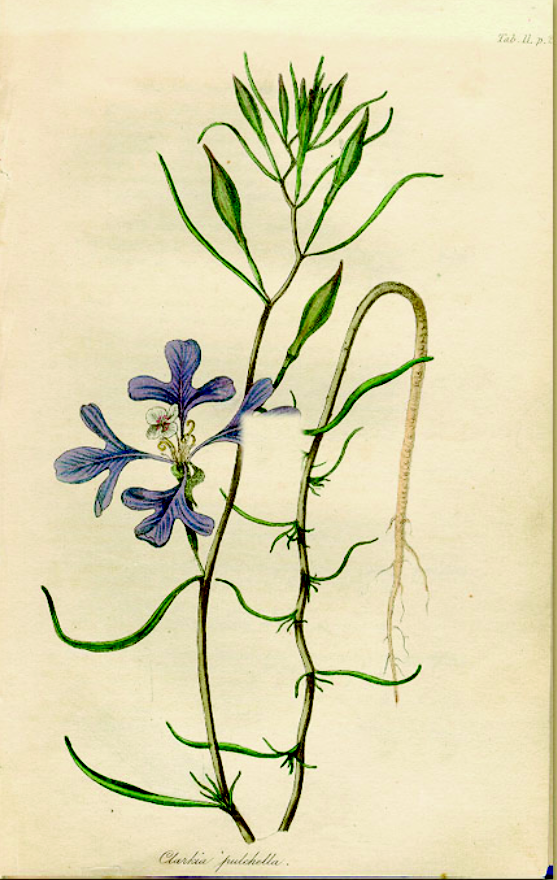 |
| Pursh's painting of Clarkia pulchella |
and seeds from the American Northwest. The Hudson's Bay Company also sponsored the trip. Douglas embarked on July 25, 1824, on the Hudson's Bay Company brig William and Ann. It left Gravesend on July 27, stopping at a few places (e.g., Rio de Janeiro, for three weeks), and traveled around Cape Horn. It dropped anchor at the mouth of the Columbia River (part of whose meandering length is now the western two-thirds of the border between Oregon and Washington) on April 7, 1825. Douglas wrote in his journal:(5)
At one o'clock noon, we entered the river and passed the sand barrier safely (which is considered dangerous and on which I learn many vessels have been injured and some wrecked).[The William and Ann, under another captain, was wrecked on this bar on March 10, 1829, with all hands lost.] Thus my long and tedious voyage of 8 months 14 days from England terminated. The joy of viewing land, the hope of in a few days ranging through the long wished-for spot and the pleasure of again resuming my wonted employment may be readily calculated. ... With truth I may count this one of the happy moments of my life.
The brig anchored on April 12 at Fort George (now in Astoria, Oregon), on the south shore of the Columbia River. However, the fort had recently been abandoned in favor of a new headquarters of the Hudson's Bay Company at Fort Vancouver (now in Vancouver, Washington), 90 miles up the Columbia River. After some botanizing and after collecting his gear from the brig, Douglas disembarked and with one Canadian and six Indians left by canoe on April 19. On April 20, he arrived at Fort Vancouver, on the north shore of the river, which became the base for his excursions.
| David Douglas |
He gathered plants in the neighborhood until June 20, having collected almost 300 specimens, which he lists and briefly describes in his journal. Then, he hitched a boat-ride further up the Columbia River with some Hudson's Bay employees. In a couple of days and 46 miles, they passed what Lewis and Clark had named "The Grand Rapids" (which are now lost, slightly above the Bonneville Dam). Traveling on, they reached what Lewis and Clark had named "The Great Falls" (later called the Celilo Falls, which were lost in 1957 with the construction of the Dalles Dam). He wrote in his journal,
From the Grand Rapids to the Great Falls (70 miles) the banks are steep, rocky, and in many places rugged. The hills gradually diminish in elevation ... .As far as the eye can stretch is one dreary waste of barren soil thinly clothed with herbage. In such places are found the beautiful Clarkia pulchella, ... .
He stayed in the area above the Great Falls for about a month, and collected around 120 specimens. He writes:
During my journey, I collected the following plants, some very interesting and will, I am sure, amuse the lovers of plants at home.
and lists about 120 more plants, recommencing with number 296. In the list is:
(329) Clarkia pulchella (Pursh), annual; description and figure very good; flowers rose color; abundant on the dry sandy plains near the Great Falls; on the banks of two rivers twenty miles above the rapids; an exceedingly beautiful plant. I hope it may grow in England.
He left on July 19,
... in an Indian canoe for the purpose of prosecuting my researches on the coast, which was in a great measure frustrated by the tribe among whom I lived going to war ... ,
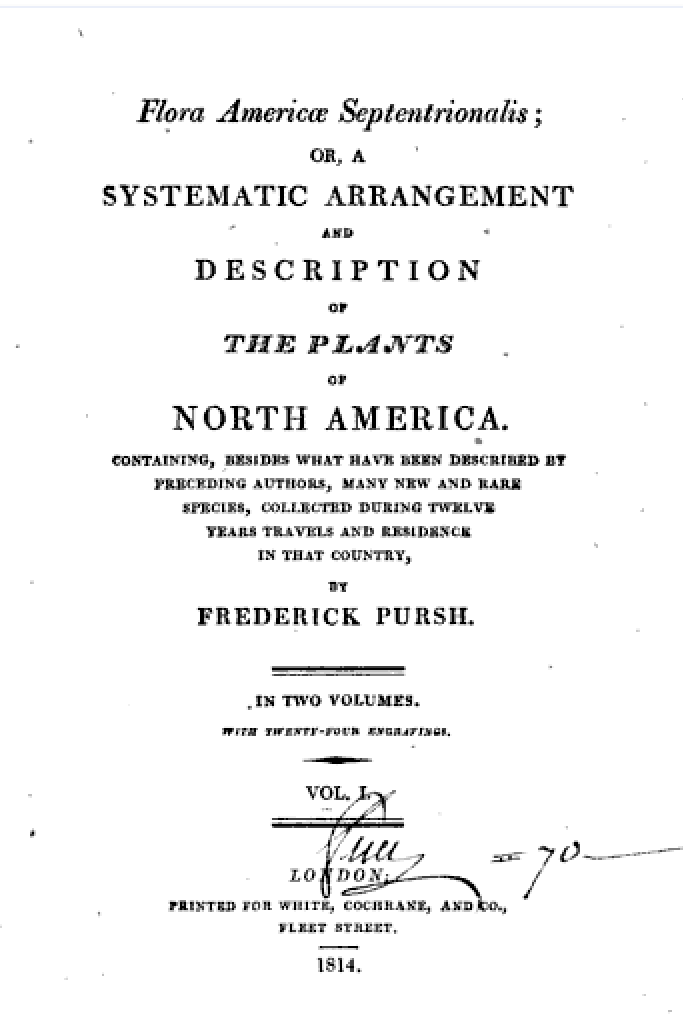 |
| Pursh's Flora |
arriving again at Fort Vancouver on August 5.
Douglas proceeded to dry his plants. He also collected some seeds from plants in the neighborhood that were already in the collection but had not earlier gone to seed. He left on August 19 to go up a tributary of the Columbia for some more collecting, and returned on August 30. On September 1 he made a second trip to the Grand Rapids, again
... to collect seeds of several plants seen in flower in June and July.
With 499 plants now on his list,
Returned on the 13th ... and learned that the vessel had returned from the North and would be despatched for England without delay. My time must now be taken up packing, arranging, and writing for a short time. From that time till October 3rd employed dividing my seeds and specimens and finishing transcribing my Journal. Wrote today to Jos. Sabine, Esq., ... . I am to-morrow morning to leave here to see my boxes safely placed in the vessel.
However, he could not go to the William and Ann, because he punctured his knee with a nail while packing the crates. So, he sent them on with instructions for their care, particularly the chest of seed. The captain sent assurances that he would personally call on Mr. Sabine.
The ship left the mouth of the Columbia River on October 25, 1825, in due course rounding Cape Horn. It arrived at London on April 15, 1826,(6) and that is how Clarkia pulchella seeds first arrived in England.
Addendum: Douglas had more adventures while collecting plants and animals (and sending them back to England) during 1826. Having wintered over, on March 20, 1827 he embarked on the Columbia River. He was aiming to reach Hudson Bay,
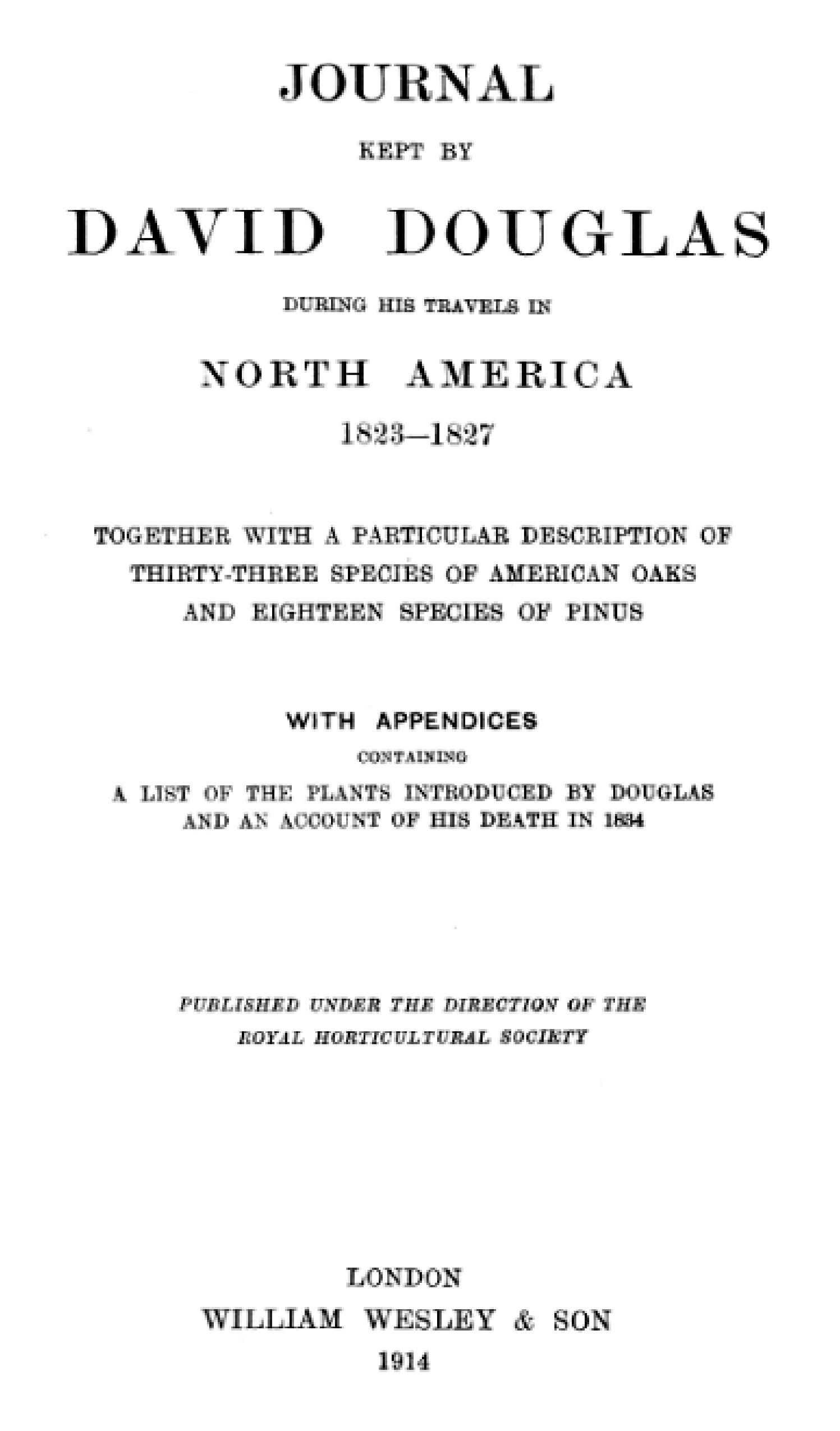 |
| David Douglas's Journal |
and from there return to England. With various companions, collecting plants all the way, he headed first for Kettle Falls, now at the northeast corner of Washington state. Then, they set out for the Canadian Rockies on April 18. They reached the Athabasca Pass, (now at the border between British Columbia and Alberta, around the middle of the western edge of Jasper National Park) on May 1. At midday, while the rest of the group was resting, Douglas became, it has been suggested, the first mountaineer in North America:
After breakfast, about one o'clock, being well refreshed, I set out with the view of ascending what seemed to be the highest peak on the north ... . The view from the summit is of that cast too awful to afford pleasure-nothing as far as the eye can reach in every direction but mountains towering above each other, rugged beyond all description ... . This peak, the highest yet known in the northern continent of America, I felt a sincere pleasure in naming "Mount Brown," in honour of R. Brown, Esq., the illustrious botanist, no less distinguished by the amiable qualities of his refined mind.
He proceeded easterly, through Edmonton, arriving at the settlement of Norway House on the northern end of Lake Winnipeg on June 16. He dawdled in the vicinity and collected some more plants. Finally, leaving there on August 18, Douglas arrived at the settlement of York Factory on the western end of Hudson Bay on July 28, 1827, concluding his journal with:
I sailed from Hudson's Bay on September 15th and arrived at Portmouth on October 11th, having enjoyed a most gratifying trip.
D. Brown
As shall be seen, pollen from Clarkia pulchella flowers, grown from the seeds shipped out by Douglas, were put to use by Robert Brown as soon as possible. Biographies of Robert Brown (1773-1858), a comprehensive book(7) as well as short and web-accessible sketches(8)(9)(10) are available, so only a brief outline shall be given here. Already in his teenage years, Brown had a strong interest in botany. While attending medical school at the University of Edinburgh, he collected plants in Scotland, and befriended people of like interest. He left the university in 1793 without his medical degree and joined the Army in 1794. He was sent in 1795 to serve in Ireland as a surgeon's mate. He spent as much of his time there as he could spare doing botany. He visited London in the summers of 1798 and 1799, networking with other botanists.
At the time, Joseph Banks (1743-1820) was the most influential botanist in England. His initial fame was gained from
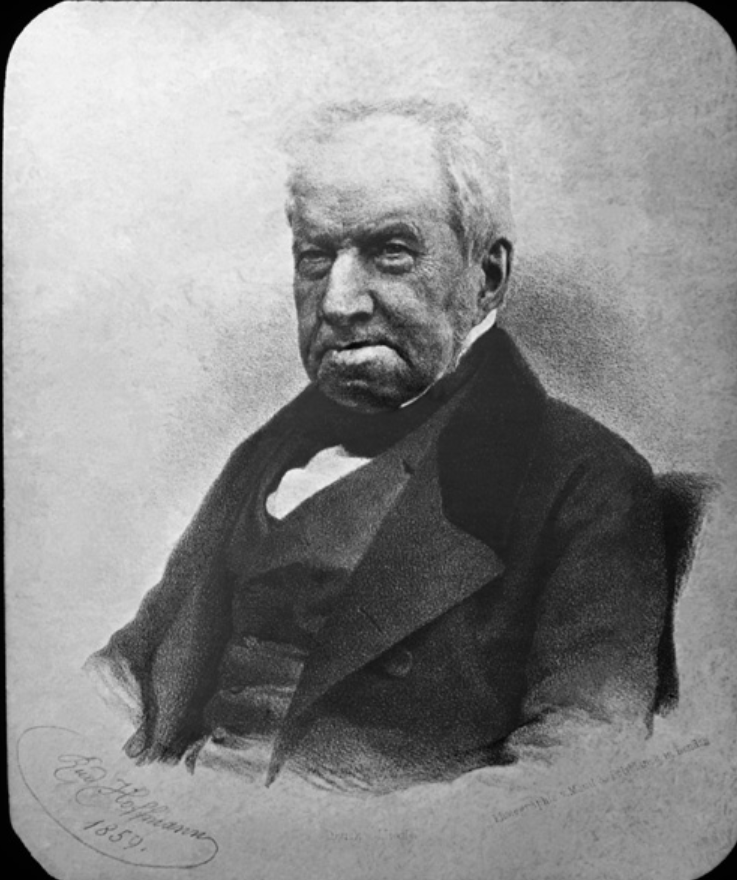 |
| Robert Brown (portrait printed after his death) |
plant collecting during Captain Cook's first expedition (1768-1771). Banks was president of the Royal Society from 1778 until his death. (He appears as a colleague of Stephen Maturin in the novels of Patrick O'Brian!). He convinced the Admiralty of the desirability of charting the coast of Australia and collecting plants there. Having heard good things about Brown, Banks wrote him a letter on December 12, 1800, offering the post of naturalist on the expedition. Brown accepted with alacrity. He obtained leave from his military duties, traveled to London, and became acquainted with Banks. Brown also met Ferdinand Bauer (1760-1826), a superb botanical illustrator, who was to accompany him on the trip. Brown prepared diligently. The ship Investigator set sail for Australia on July 18, 1801. Brown had many adventures as an indefatigable collector of plants (but also of animals, birds, fishes, reptiles, insects and rocks). He returned on October 7, 1805, having found thousands of new species of plants.
Brown's work had been so impressive that, before the year ended, he was chosen to be librarian of the Linnean Society. With salary and free lodgings in prospect, he quit the army. Also, Banks convinced the Admiralty to continue Brown's salary, and that of Bauer, as they codified their work. In the next five years, Brown wrote ground-breaking papers on plant classification, often aided by microscopic observations. In 1810 he published Volume 1 describing his Australian plants. The projected Volume 2 was never published, because the first volume was a financial failure, but much of the remaining material later emerged in various papers. In that year, Banks hired him as the librarian and curator of Banks's herbarium. Together with his arrangement with the Linnean Society, this made him financially secure (the Admiralty stipend ended the following year).
Brown was extremely active professionally, at the hub of botanical research in England, and was increasingly admired throughout Europe, not least because of his remarkably perceptive microscopy. A forte was characterizing plants by the nature of their reproductive organs and seeds, a scheme that was superior to the Linnean system then prevalent.
Banks died in the middle of 1820. He left his library, herbarium, an annuity and eventually the lease to his house to Brown, with the stipulation that Brown take up residence there. The botanical materials were to go eventually to the British Museum, subject to Brown's convenience. He leased half of the house to the Linnean society for their collections and use, and soon resigned from his paid Linnean positions. In 1825 he declined an offer of the Linnean Society, writing that one who occupied the proffered position of Secretary
... should unquestionably have the habits of a man of business and be perfectly regular in matters of correspondence. That I do not possess such habits at present is but too well known to all my friends and whether I should ever acquire them is at least very doubtful.
Nonetheless, despite his protestation of lack of business acumen, his negotiations with the Trustees of the British Museum for the transfer of Banks's library, which took more than a year, concluded in September 1827 with satisfying success. He was to become the underlibrarian in charge of the collection. There was a good stipend for two days work a week and a full-time paid assistant John Joseph Bennett (1801-1876) who became a friend and eventually Brown's executor. The terms were such that he retained his rooms, stipend from Banks and control of Banks's herbarium. During these negotiations, Brown was conducting the investigations of concern here.
--------------------------------------------------------------------------
1) A transcript of an interesting historical talk about the Lewis and Clark expedition and its genesis, by Robert S Cox, given at Monticello in 2004, may be found at http://www.monticello.org/streaming/speakers/cox.html
2) A wealth of material on the Lewis and Clark expedition and related topics appears at http://www.lewis-clark.org/. For a discussion of Clarkia pulchella, a picture of the plant, and Pursh's drawing of it which appeared in his Flora, click on "Natural History," then "Plants," then "Clarkia." It is also interesting to read here about the lives (and tragic deaths of the first three) of Lewis (see also http://www.prairieghosts.com/meriwet.html), Pursh (see also J. Ewan, Proc. Amer. Phil. Soc, {\bf 96} \# 5, 599 (1952)), available at Googlebooks), Douglas (see also http://www.coffeetimes.com/daviddouglas.htm) and Barton, all by the American botanist J. Reveal.
3) Original Journals of the Lewis and Clark Expedition, 1804-1806 (Dodd, Mead and Company, New York, 1905), edited by R. G. Thwaites, Volume 5, p.95.
4) J. Loudon, The Ladies Flower Garden of Ornamental Annuals (W. Smith, London 1842), pp. 56-57 and her beautiful illustration of Clarkia plants between these two pages. It may be viewed at http://books.google.com/. A biography of Jane Loudon may be found at http://www.shigitatsu.com/LOUDON%201.htm.
5) D. Douglas, Journal kept by David Douglas during his travels in North America 1823-1827 (W. Wesley and son, London 1914), W. Wilks and H. R. Hutchinson eds. This is a marvelous first-hand adventure story. It
can be read or downloaded at the Washington State historic site, http://www.secstate.wa.gov/history/publications.aspx (click on Exploration and Early Travel)
6) We are indebted to Bronwen Quarry of the Hudson's Bay Company archives for furnishing information about the dates of travel and fate of the William and Ann.
7) D. J. Mabberley, Jupiter Botanicus: Robert Brown of the British Museum (J. Cramer, Braunschweig 1985). The biographical details given in this paper are almost exclusively from this authoritative source.
8) Wikipedia contains a short biography of Robert Brown, as does the Australian dictionary of Biography, http://www.adb.online.anu.edu.au/biogs/A010149b.htm. See also the Britannica site, http://www.answers.com/topic/robert-brown.
9) B. J. Ford, http://www.brianjford.com/wbbrowna.htm. This web site also contains a photograph of the Bancks-made Linnean Society microscope of Brown's, as well as a comparison of a view with a single lens and a compound microscope of the time, and a short video of Brownian motion of milk fat droplets. http://www.microscopy-uk.org.uk/dww/home/hombrown.htm also has a video of milk fat droplets undergoing Brownian motion, of sizes .5 to 3microns, with tips on how to duplicate the observation.
10) Robert M. Mazo, Brownian Motion: Fluctuations, Dynamics and Applications (Clarendon Press, Oxford 2002). The first few pages, available at googlebooks, http://books.google.com/, and also at Amazon, http://www.amazon.com, contains a brief treatment of the first two sections of this paper. See also Edward Nelson, Dynamical Theories of Brownian Motion (Princeton University Press, Princeton 1967), which is available at http://www.math.princeton.edu/~nelson/books/bmotion.pdf, Chapter 2. Both are excellent texts on "mathematical" Brownian motion.